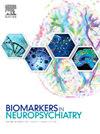开发用于阿尔茨海默病早期风险评估的非侵入性分子标记
Q2 Medicine
引用次数: 0
摘要
阿尔茨海默病(AD)是一种异质性神经退行性疾病,在早期没有标准的生物标志物来检测或确认其风险。阿尔茨海默病在全球65岁及以上人群中的患病率呈指数增长。目前的改进已经揭示了该疾病的病理生理和临床诊断测试,针对神经学变化(神经变性,淀粉样蛋白前体蛋白代谢和缠结病理),使用精确的PET/MRI成像和xMAP/SIMOA(多重同时检测/单分子阵列)来鉴定和量化患者脑和脑脊液(CSF)中的β-淀粉样蛋白(Aβ40, Aβ42),总tau (T-tau)和磷酸化tau (P-tau)蛋白。然而,由于成本、可及性、标准化、程序限制和监管批准,它们在常规临床实践中的诊断应用仍然具有挑战性。需要进一步的研究来建立负担得起的、患者友好的、简单、快速和强大的生物标志物,用于早期AD的检测、进展和治疗管理。近十年来,基于血液的阿尔茨海默病临床前诊断研究和临床实践取得了显著进展。新出现的文献支持新的分子生物标志物和血液特征基因对提前检测和预测AD的重要性。本文综述了这些基于血液的目标生物标志物在阿尔茨海默病的早期疾病检测、合并症风险预测和治疗管理中的潜在应用。本文章由计算机程序翻译,如有差异,请以英文原文为准。
Developing non-invasive molecular markers for early risk assessment of Alzheimer's disease
Alzheimer's disease (AD) is a heterogeneous neurodegenerative disease, with no standard biomarker(s) to detect or confirm its risk at an early stage. The prevalence of AD increases exponentially worldwide in people of ages over 65 and older. Current improvements have unveiled the disease's pathophysiology and clinical diagnostic tests, targeting the neurological changes (neurodegeneration, amyloid precursor protein metabolism and tangle pathology) with precise PET/MRI imaging and xMAP/SIMOA (Multiplex simultaneous detection/single molecule array) to identify and quantify β-amyloids (Aβ40, Aβ42), total tau (T-tau) and phosphorylated tau (P-tau) proteins in the brain and cerebrospinal fluid (CSF) of patients. However, their utility for diagnosis in routine clinical practice is still challenging because of cost, accessibility, standardization, procedural limitation, and regulatory approval. Further research is needed to establish affordable, patient-friendly, easy, quick, and robust biomarkers for early AD detection, progression, and therapeutic management. Research on blood-based preclinical diagnosis and clinical practice for AD has advanced significantly in the last decade. Emerging literature supports the importance of new molecular biomarkers and signature genes from blood to detect and predict AD in advance. This review examines the potential applications of these blood-based target biomarkers for early disease detection, co-morbid condition risk prediction, and treatment management of AD.
求助全文
通过发布文献求助,成功后即可免费获取论文全文。
去求助
来源期刊

Biomarkers in Neuropsychiatry
Medicine-Psychiatry and Mental Health
CiteScore
4.00
自引率
0.00%
发文量
12
审稿时长
7 weeks
 求助内容:
求助内容: 应助结果提醒方式:
应助结果提醒方式:


